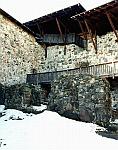|

All pictures are copyright by Gary Martens, All rights reserved.
Click on image to see larger version
 |
The Raseborg
Castle, the castle on the rock, from the west side. The oldest parts
of the castle date from the 13th century, and was probably founded
in 1374. The castle was of great strategic importance in the 15th
century, when it protected the town of Tuna, an important trading
place in southern Finland. When castle construction began, the castle
was surrounded by water. |
 |
Just inside
the entrance to Raseborg Castle, the inner chambers to the left,
the outer courtyard to the right. The importance of the castle declined
in the mid-1500s, and the castle was left empty for over 300 years. |
 |
The wall
and entrances to the inner chambers of Raseborg Castle. |
 |
The second
level of the outer wall of Raseborg Castle. |
 |
The second level of the main chamber of Raseborg Castle.
|
 |
The walkway around the third level of the main chamber of Raseborg
Castle.
|
 |
A room in the circular tower of Raseborg Castle.
|
 |
The outer courtyard looking towards the main chamber area of
Raseborg Castle.
|
 |
Raseborg
Castle at Raasepori, near Snappertuna. It was of great strategic
importance from the 1400's to the mid 1500's. Tuna, as it was called
then, was an important trading city in southern Finland, and the
castle provided protection. From about 1361 until the 1550s, the
castle was near a major trading route, and large amounts of tax
paid in goods passed this area. Imports into Finland consisted of
salt, grain, spices, fabrics and wine. In the 1550s, King Gustavus
Vasa transferred power and authority from this castle to the newly
founded towns of Tammisaari and Helsinki. |
Return to the Castles
Page
© 1999-2008, Gary Martens, All Rights Reserved -- This page last
modified: Friday, 7 November 2008
|

